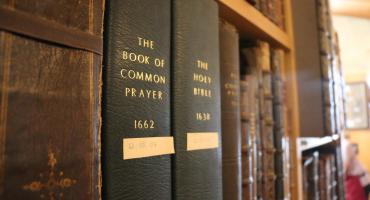Spend some time exploring the cathedral inside and out looking for textures and patterns in the surfaces you come across. ‘Harvest’ them using the technique of frottage and incorporate them into mixed media collages in this relaxed and enjoyable art workshop.
Frottage was first described by the artist Max Ernst in 1925 when his fascination with patterns in the grain of a wood floor led him to create rubbings of the surface. He subsequently experimented with all sorts of materials including leaves and linen and combined them to create a series of works under the title ‘histoire naturelle’ (Natural History).
The inspiration for the session will take the nesting Peregrines as a starting point through the use of photographs and live web cam, as well as spending time in the Cathedral looking at visual representations of birds within tapestries, paintings and stained glass. Participants can choose to sketch and take photographs or use visual resources available within the workshop to create their collages.
We will be using two methods to harvest images; initially collecting a series of rubbings of surfaces using different materials and papers to create interesting effects which can later be used for collage. Secondly, creating a composite frottage by combining different surfaces on one piece of paper to create an image.
Simple and quick to do, the method is accessible and suitable for all levels of ability. It makes us look deeper into what is around us and frees us from the concerns of complex technique and output.
Collages can be large or small and abstract or representational depending on your approach. Cardboard or thick cartridge paper will be used as a surface on which to create your work. There is no need to worry about drawing ability as outline images can be traced if you prefer to have a starting point.
Within the collage part of the workshop there will be time for you to experiment with printed and coloured papers as well as your frottage samples, this will allow further textures and patterns to be incorporated if desired. Cutting vs. tearing, the use of different pastes and the incorporation of other media will be discussed.
The workshop aims to:
- Provide an exciting opportunity to try out 2 different techniques to create artworks using the theme of Peregrines and representations of birds within the Cathedral as a starting point.
- Introduce some art history and natural history into the creative process.
- Support learners to gain confidence to develop creative ideas into images.
- Make the workshop accessible through tutor demonstrations, samples and examples of the work of other artists.
- Promote a positive and fun atmosphere where participants can be creative in a safe and supportive environment.
- apron
- sketchbook for ideas
- images or papers that excite and inspire you (optional)
- folder to carry your work home
Who is .jpg) the course tutor? Karen Swann has been teaching and facilitating workshops within the community setting for several years. She works part time as a learning support assistant at a local school and is an Ambassador for the Pallant Community Programme. As part of her Pallant House Gallery role Karen regularly assists in joint workshops with the Learning and Engagement Department at Chichester Cathedral.
the course tutor? Karen Swann has been teaching and facilitating workshops within the community setting for several years. She works part time as a learning support assistant at a local school and is an Ambassador for the Pallant Community Programme. As part of her Pallant House Gallery role Karen regularly assists in joint workshops with the Learning and Engagement Department at Chichester Cathedral.
A practising artist and printmaker, Karen completed a Graduate Diploma at West Dean College in 2015 following a career as a Healthcare Scientist. Using a variety of techniques and media, her work is inspired by everyday encounters with nature and the environment and often reflects her interest in birds. She is a member of Chichester Art Society and exhibits regularly in Sussex. If you would like to see some examples of her work follow the links below.
https://www.chichesterarttrail.org/venues/92/karen-swann/
Doors open 9.45am.
For further details and to book tickets click on the link to the right. Tickets can also be bought in person from the Cathedral Cloisters Shop.

